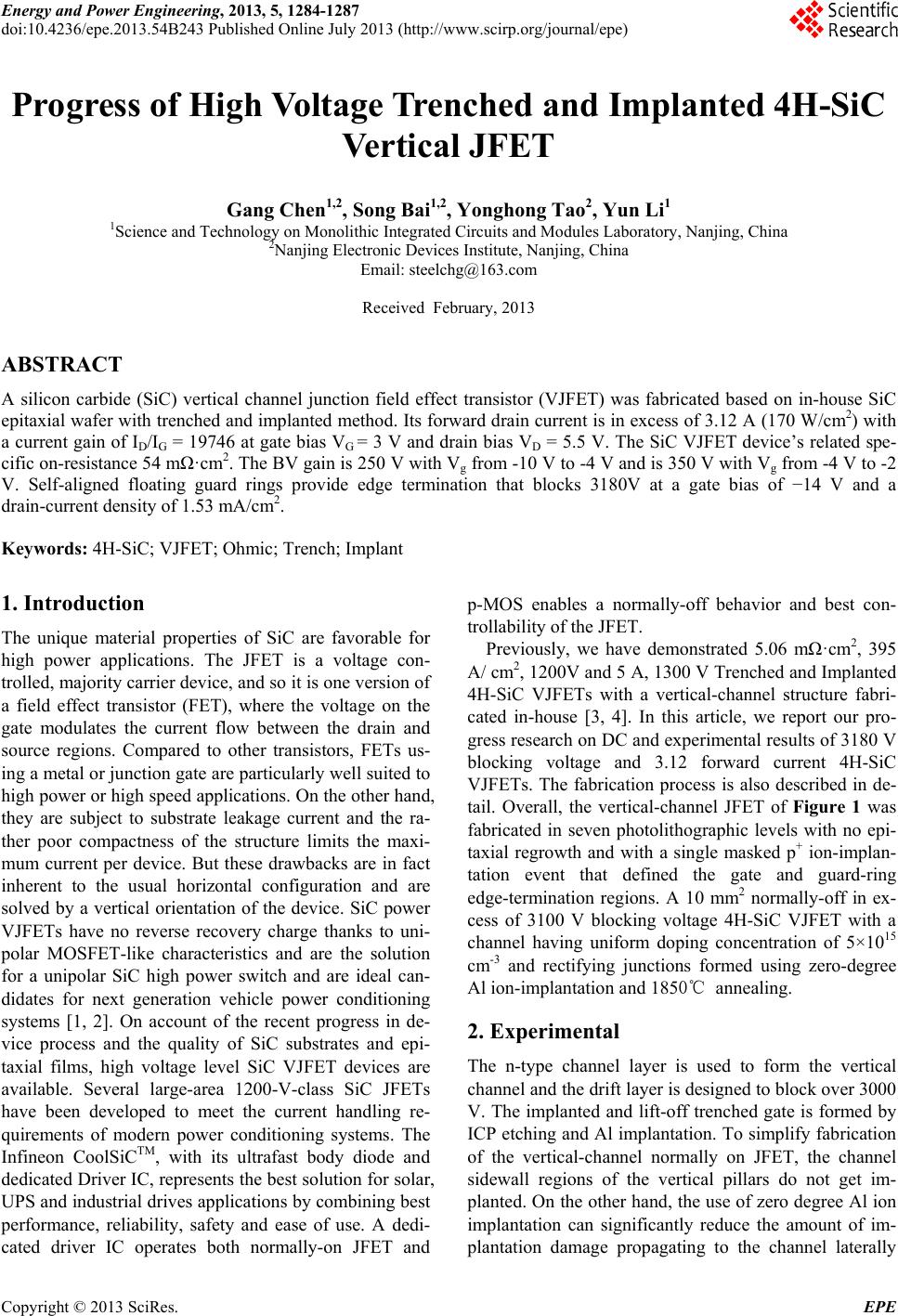
Energy and Power Engineering, 2013, 5, 1284-1287
doi:10.4236/epe.2013.54B243 Published Online July 2013 (http://www.scirp.org/journal/epe)
Progre ss of High Voltage Trenched and Implanted 4H-SiC
Vertical JFET
Gang Chen1,2, Song Bai1,2, Yonghong Tao2, Yun Li1
1Science and Technology on Monolithic Integrated Circuits and Modules Laboratory, Nanjing, China
2Nanjing Electronic Devices Institute, Nanjing, China
Email: steelchg@163.com
Received February, 2013
ABSTRACT
A silicon carbide (SiC) vertical channel junction field effect transistor (VJFET) was fabricated based on in-house SiC
epitaxial wafer with trenched and implanted method. Its forward drain current is in excess of 3.12 A (170 W/cm2) with
a current gain of ID/IG = 19746 at gate bias VG = 3 V and drain bias VD = 5.5 V. The SiC VJFET device’s related spe-
cific on-resistance 54 mΩ·cm2. The BV gain is 250 V with Vg from -10 V to -4 V and is 350 V with Vg from -4 V to -2
V. Self-aligned floating guard rings provide edge termination that blocks 3180V at a gate bias of −14 V and a
drain-current density of 1.53 mA/cm2.
Keywords: 4H-SiC; VJFET; Ohmic; Trench; Implant
1. Introduction
The unique material properties of SiC are favorable for
high power applications. The JFET is a voltage con-
trolled, majority carrier device, and so it is one version of
a field effect transistor (FET), where the voltage on the
gate modulates the current flow between the drain and
source regions. Compared to other transistors, FETs us-
ing a metal or junction gate are particularly well suited to
high power or high speed applications. On the other hand,
they are subject to substrate leakage current and the ra-
ther poor compactness of the structure limits the maxi-
mum current per device. But these drawbacks are in fact
inherent to the usual horizontal configuration and are
solved by a vertical orientation of the device. SiC power
VJFETs have no reverse recovery charge thanks to uni-
polar MOSFET-like characteristics and are the solution
for a unipolar SiC high power switch and are ideal can-
didates for next generation vehicle power conditioning
systems [1, 2]. On account of the recent progress in de-
vice process and the quality of SiC substrates and epi-
taxial films, high voltage level SiC VJFET devices are
available. Several large-area 1200-V-class SiC JFETs
have been developed to meet the current handling re-
quirements of modern power conditioning systems. The
Infineon CoolSiCTM, with its ultrafast body diode and
dedicated Driver IC, represents the best solution for solar,
UPS and industrial drives applications by combining best
performance, reliability, safety and ease of use. A dedi-
cated driver IC operates both normally-on JFET and
p-MOS enables a normally-off behavior and best con-
trollability of the JFET.
Previously, we have demonstrated 5.06 mΩ·cm2, 395
A/ cm2, 1200V and 5 A, 1300 V Trenched and Implanted
4H-SiC VJFETs with a vertical-channel structure fabri-
cated in-house [3, 4]. In this article, we report our pro-
gress research on DC and experimental results of 3180 V
blocking voltage and 3.12 forward current 4H-SiC
VJFETs. The fabrication process is also described in de-
tail. Overall, the vertical-channel JFET of Figure 1 was
fabricated in seven photolithographic levels with no epi-
taxial regrowth and with a single masked p+ ion-implan-
tation event that defined the gate and guard-ring
edge-termination regions. A 10 mm2 normally-off in ex-
cess of 3100 V blocking voltage 4H-SiC VJFET with a
channel having uniform doping concentration of 5×1015
cm-3 and rectifying junctions formed using zero-degree
Al ion-implantation and 1850℃ annealing.
2. Experimental
The n-type channel layer is used to form the vertical
channel and the drift layer is designed to block over 3000
V. The implanted and lift-off trenched gate is formed by
ICP etching and Al implantation. To simplify fabrication
of the vertical-channel normally on JFET, the channel
sidewall regions of the vertical pillars do not get im-
planted. On the other hand, the use of zero degree Al ion
implantation can significantly reduce the amount of im-
plantation damage propagating to the channel laterally
Copyright © 2013 SciRes. EPE